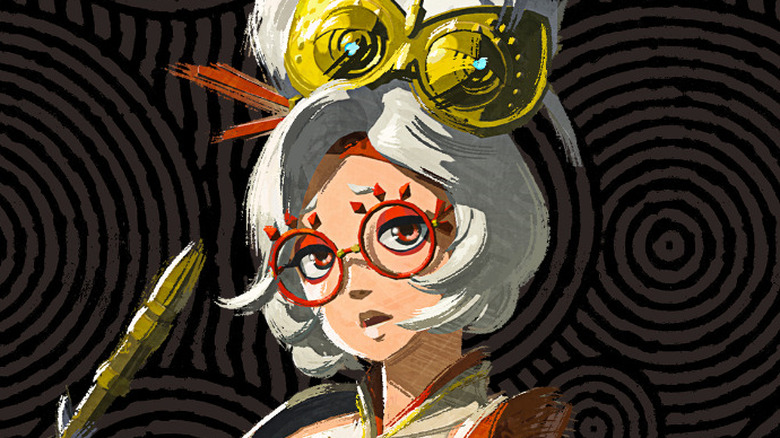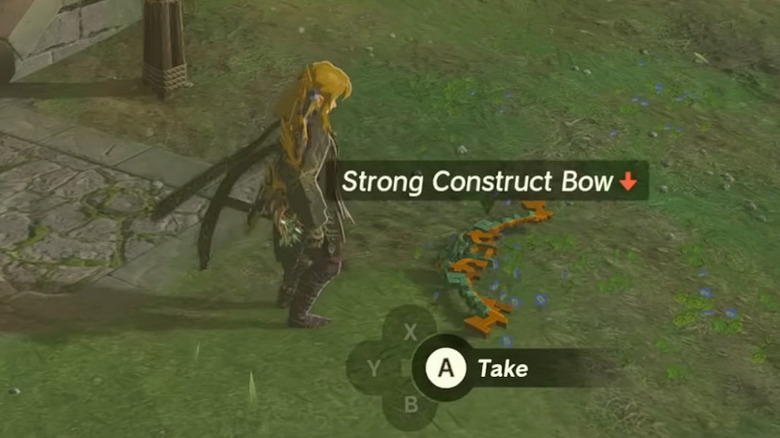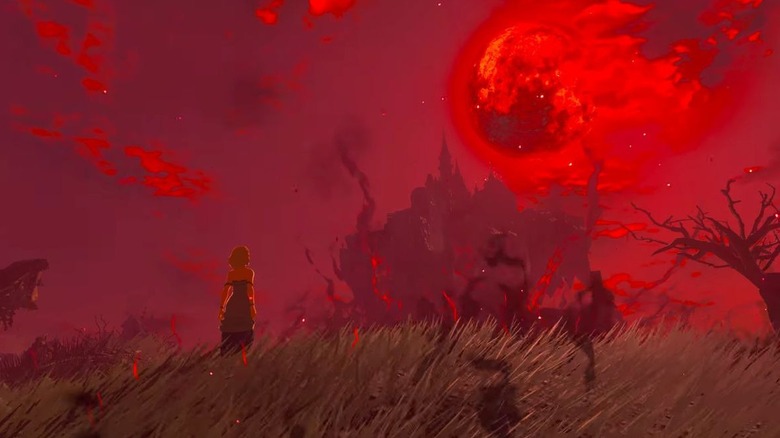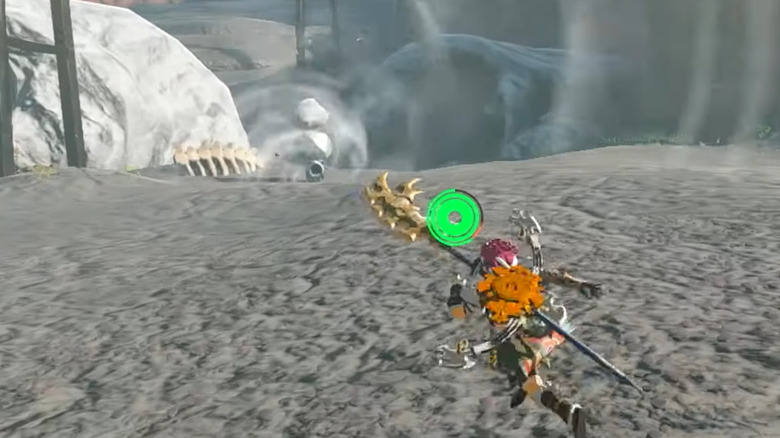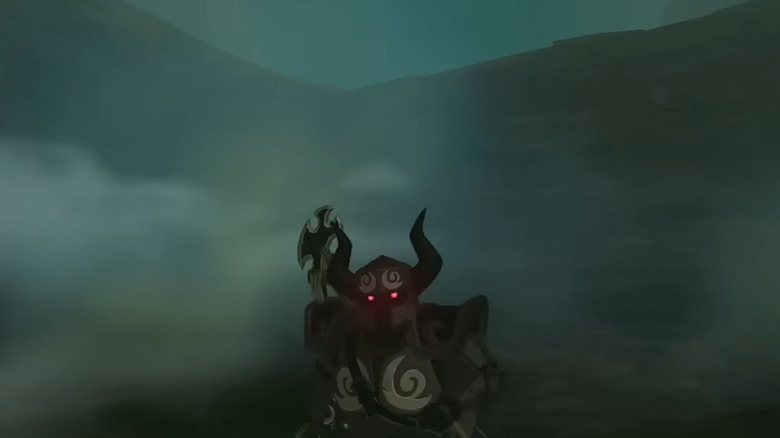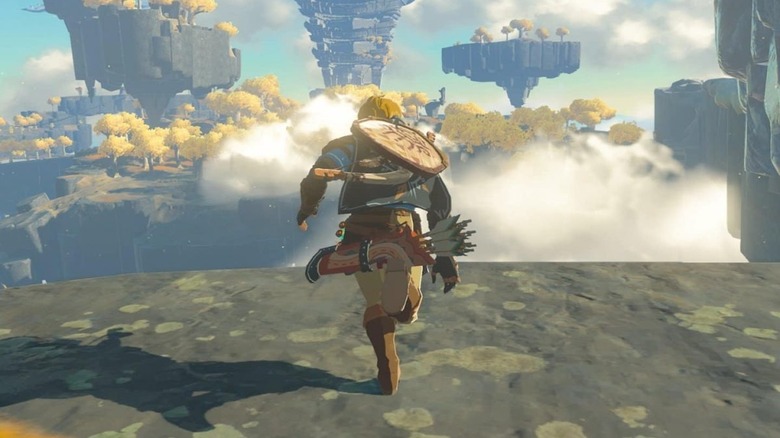The Best Glitches In Zelda: Tears Of The Kingdom
Speedrunners and causal rule-breakers love to color outside the lines set in place by game developers. Luckily for them, when the sprawling landscapes of "The Legend of Zelda: Tears of the Kingdom" are paired with its innovative building and fusing mechanics, you get a game ripe with glorious glitches and exploits.
In fact, "Tears of the Kingdom" is so intrinsically linked with glitches that some of its core mechanics stem from internal bug hunting. In an interview with Polygon, game developer Hidemaro Fujibayashi revealed, "the Ascend ability was actually the result of a debug feature that we have in the game." In other words, the developers had so much fun using an exploit of their own design that they included it in the game.
And Nintendo certainly needed all the debugging tools it could generate. Within just a few weeks of its release, "Tears of the Kingdom" players began sharing exploits via Discord, Reddit, and other social platforms. Nintendo was quick to act, ironing out a ton of glitches in Patch 1.1.2. Many remain, however, and more are being discovered every week.
Due to the whack-a-mole nature of glitches, this article will specify which of these work on specific game versions. If you haven't run an update on "Tears of the Kingdom" recently, odds are good that you can pull off many of these tricks.
Food Buff Swapping (1.0.0. - 1.1.1.)
The satisfying cooking mechanics from "The Legend of Zelda: Breath of the Wild" were greatly expanded in "Tears of the Kingdom." With over 200+ recipes to experiment with, players are likely to create dishes with effects they'll want to reproduce time and time again. Hearty dishes can provide extra health, others replenish stamina, etc. The benefits of having the right food for every situation are immense, but one must always have the right ingredients.
But what if players only needed to gather the correct ingredients once to get an infinite supply of their desired food buff? Well, the Food Buff Swapping glitch enables just that. Just cook a dish with the desired food effect next to a vendor who sells food, and the vendor will then sell their food to you with the player's desired buff already attached to it. Players can cook the most powerful dishes with rare ingredients once, then buy cheap copies of the rare and powerful effects. When it comes to controller inputs, this is probably the easiest bug in this list to replicate.
Infinite Durability Master Sword (1.0.0 - 1.1.1)
As one of the most coveted and powerful weapons in "The Legend of Zelda: Tears of the Kingdom," the Master Sword inevitably wound up in the sights of glitch hunters. The weapon degradation system from "Breath of the Wild," which carried through into "Tears of the Kingdom," makes using Link's ultra-powerful weapons come at a crucial cost to their durability. Use powerful weapons like the Master Sword too much, and they will break.
That is the game's intention, at least. However, those who desire an infinitely durable Master Sword can achieve their goal through a complicated string of item duplication methods. Using a process called Save Load Duping, players can trick the game into duplicating items (in this case, the Master Sword) across different saves. Save Load Duping is one of the more involved glitches, with multiple strings of precise inputs required to complete it.
Thankfully, YouTubers like Abahbob have provided helpful walkthroughs of the process (seen above), demonstrating how players can Save Load Dupe the Master Sword into a save from the game's prologue. There, in its duped form, the Master Sword renames to "Msg Not Found." And just like that, players can carry a 30 damage, indestructable Master Sword from the very start of the game.
Midair Sorting Duplication (1.0.0. - 1.1.1)
The first few weeks following the release of "Tears of the Kingdom" saw the proliferation of numerous item duplication methods. Most of these early item duplication exploits (patched out in version 1.1.2) relied on different variations of manipulating the game's menu and inventory systems.
The most straightforward version, Midair Sort Duplication, requires players to be airborne on a shield jump or a paraglider. Once there, players must then pause the game, navigate to the inventory menu, and hold the item they want to duplicate. Then, pressing the Y and + buttons simultaneously creates a game state where the held items are sorted back into the player's inventory while also dropping to the ground.
Basically, the Hyrulian time-space continuum is ripped apart from menu input overload, and item duplication has occurred. This menu sorting duplication method also works great for creating copies of Zonai items, which are harder to come by than weapons.
Sort and unpause, no items deleted, all versions #TearsOfTheKingdom #Zelda #NintendoSwitch pic.twitter.com/x4uehYJWGo
— Zas (@zasoot) May 22, 2023
Zuggling (1.0.0. - 1.1.2.)
The most complicated and in-depth glitch featured here, Zuggling, refers to a string of inputs that allow Link to stack and equip infinite copies of any weapon in his hands simultaneously. All of the videos showing "Tears of the Kingdom" bosses getting one-shot use some form of this glitch. The exploit's original incarnations, Map Zuggling and Save Load Zuggling, met their end in patch 1.1.2 — but new, more complicated versions have arisen for version 1.1.2 that still enable infinite damage stacking. Zuggling enables the instant takedown of over-leveled bosses, so it is now a core part of Any% "Tears of the Kingdom" speedruns.
Map Zuggling and Save Load Zuggling use similar methods of manipulating the rune menu, quick menu, and the game map within split seconds to trick the game state into allowing Link to hold multiple weapons.
Post-1.1.2 Zuggling combines known Zuggle methods with another glitch called Equipment Smuggling, which allows Link to equip an item without pulling it from his inventory. This is achieved by holding equipment and pausing the game right before getting shocked, then quickly dropping the currently held equipment and exiting the inventory screen.
Weapon Snuggling (WS) and Ghost Gear (GG) in #Zelda #TearsOfTheKingdom on #NintendoSwitch
Drop Links equipped gear right before he gets zapped by electricity 🌚 pic.twitter.com/xr3gzS9fPI
— nan_gogh (@GoghNan) June 3, 2023
Forced Blood Moons (1.0.0. - 1.1.2)
Blood Moons in "Zelda: Tears of the Kingdom" can be valuable events, acting as a world reset every seven in-game days. Slain monsters revive, items repopulate, and ore deposits regenerate. Even cooking buffs are boosted during Blood Moons, so being able to trigger one at a moment's notice is valuable.
The trick behind this glitch is simply overloading the game with visual information to make it lag. The most reliable way to produce the type of lag required to trigger this weird interaction is relatively easy to perform. Players first must find a sizable collapsable wall. Then, they must get into Bullet Time by any means (jumping off a wall, falling, etc.). With a multi-shot bow equipped, players must unload as many arrows as possible into the collapsable wall. Opal and Topaz-tipped arrows typically produce enough visual noise to generate the necessary lag for a Blood Moon to force trigger, while a 5x multi-shot bow will boost that even more.
Once the game starts lagging, players can then reload their last main save, at which point a Blood Moon will commence.
Rock Octorok Duplication (1.0.0. - 1.1.2)
Glitches come in all shapes and sizes. Some of them are replicable anywhere in the world. Some of them require particular story-locked areas or a combination of progression-locked mechanics. Others, however, are only performable under a specific set of circumstances. Rock Octorok Duplication is one of those more limited glitches.
Rock Octoroks will suck up the first weapon thrown in front of them and spit it back at Link a few seconds later, repaired and with a random weapon effect. To abuse this mechanic, players must use Recall on the item right before it gets sucked up by the Rock Octorok. If done correctly, the recalled item will remain in place, but the Octorok will still shoot out a repaired version! This method also works for non-weapon item duplication, as players can fuse the desired item to a weapon before the Octorok duplicates it.
Rock Octoroks can only spit back a weapon like this once per Blood Moon. As a result, players can mark all the Rock Octoroks on the map as weapon/item duplication spots and return to them after a new Blood Moon for further repairs and duplication.
Overworld Mist Duplication Method (1.0.0. - 1.1.2)
With so many item duplication methods patched out in version 1.1.2, players who keep their game up to date have had to farm all their desired items fairly — until they figured out how to exploit the barrier between the Overworld and The Depths. The Overworld Mist Duplication method requires players to have access to Tobio's Hollow Chasm, a multi-shot bow, and lots of arrows.
In Tobio's Hollow Chasm, located at around -158 degrees on the map's y-axis, there is a transitory area between the overworld and The Depths. The barrier presents itself when the surrounding mist turns from green to blue. Players can then fuse their desired item with an arrow and shoot it at the barrier's horizon. If done correctly, the arrows will stick in the border, duplicating the fused items as many times as it was shot (meaning a multi-shot bow is preferable).
For as long as this stays in the game, this method will remain one of the best ways to replicate resources.
Infinite Sprinting (1.0.0. - 1.1.2)
The little green wheel denoting Link's stamina bar dictates much of the gameplay in "Tears of the Kingdom." It is responsible for restraining how far and fast Link can move about the world, as well as other feats of strength. As such, players quickly look to unshackle themselves from these limits by completing shrines and upgrading their stamina bar. But what if players could freely sprint around the world without upgrading their stamina even once?
There are multiple ways to achieve infinite sprinting, but they all rely on the same basic concept. Each infinite sprinting technique requires players to initiate a sprint and then instantly input another command that stops Link's sprint but carries its momentum forward. For example, players can start a sprint and quickly input a Fuse or Ultrahand command. With the momentum carried forward, the process repeats itself automatically, and no stamina drains from Link.
The fastest type of infinite sprinting found so far is known as Crouch Throw Tap Sprinting. The controls for this version are a bit trickier: Players must initiate a sprint, then crouch, and then input a string of B –> R –> B. While it may seem like a hassle to input so many commands, players will go to just about any lengths to eke out a little extra speed.
Anti-Gravity (1.0.0. - 1.1.2)
A large part of glitch-hunting relies on processes similar to the scientific method. These methodologies ask as many refining questions as possible to obtain more clarified results. Getting to that point — knowing how and why a glitch works — is a challenging process. And there don't seem to be obvious answers to those questions when it come to the Anti-Gravity glitch in "Tears of the Kingdom."
This aptly-named glitch keeps Link strung up in the air, incapable of falling any lower on the y-axis. Instead of allowing a diving sequence to initiate, this glitch creates an invisible 'floor' that Link is not capable of passing through.
While there is not yet a standard methodology for reproducing this effect, the reported instances of this glitch share the fact that the player had just completed a quest. Interestingly, in a game that emphasizes game mechanics built around verticality, it turns out that switching off gravity can actually be detrimental to the player! Whereas most of these other glitches help the player break the game in advantageous ways, this amusing bug can stop you in your tracks.
Springdolling (1.0.0. - 1.1.2)
Zonai devices in "Tears of the Kingdom" have opened up all new gameplay possibilities. Many Zonai machinations are related to movement, from attaching fans to a speedboat or setting up a spring in the right spot to ragdoll Link across the map. As explained by Mozz on YouTube, the latter Zonai device is necessary for pulling off the so-called "Springdoll" glitch.
Producing the Springdoll action is not too complicated, but requires a few precise input timings. First, players must stand next to a spring set up in their intended direction. Then, players input a shield surf: ZL to wield the shield → X to jump → A to start shield surfing. Upon landing, players then press Y to queue a heavy attack. As soon as Link hits the spring with the shield, players finally spin, pause the game, and unequip the shield. If done correctly, the Springdoll launch will be triggered.
The effect not only looks hilarious, but it also moves Link across the map quickly. With that in mind, you may want to consider punishing Link with a spring-punch to the gut the next time he needs to clear a large distance!
Recall Launch (1.0.0. - 1.1.2)
Fast movement is the name of the game for speedrunners, so finding the best ways to manipulate movement around the map is key for them. The Recall Launch technique is one of the fastest ways to cover ground in all of "Zelda: Tears of the Kingdom."
The Recall Launch only requires a flat surface, a throwable spear, and a combination of the Ultrahand and Recall abilities. Players must throw their spear at the edge of the flat surface they are working with (either a plank or a wing). As quickly as possible after throwing the spear, they must Recall the weapon and then use Ultrahand to stick it to the flat surface. The angle or tilt of the spear should be close to parallel with the edge of the flat surface for the most consistent results.
Following that, players must run onto the flat surface, Recall the weapon, and then launch into the air. The spear and flat surface in use for this glitch are consumed, but it can launch Link to high altitude in the sky. These tricky inputs may prevent Recall Launch from being totally reliable for speedrunners, but it is probably the fastest way to get Link into the sky when pulled off correctly.
Longer Horizontal Jumps (1.0.0. - 1.1.2)
Similar to the enhancing effects of Infinite Sprinting techniques, players can exploit a glitch to achieve longer horizontal jumps. And the best part is, these inputs are relatively easy!
Players simply jump sideways when climbing or sideways crouch-jump from a heightened surface and perform an aerial attack at the same time. The aerial attack will carry Link's horizontal jump momentum further than his average jump would.
This movement pattern does not require the use of any special items or unlocked locations, so it can be a part of a player's arsenal from the beginning of the game. Additionally, this move finishes with an aerial attack, so players can also use it against monster camps to rain death from above. Considering how often players have to jump off ledges in this game, not to mention how easy this glitch is to perform, this might be one of the most widely useful glitches out there.
Fall Damage Cancel (1.0.0. - 1.1.2)
Moving on from the low stakes and easy-to-execute nature of Longer Horizontal Jumps, the Fall Damage Cancel glitch ramps up both the input difficulty and the immense pressure to execute it correctly.
In order to perform a Fall Damage Cancel, also known as Jumpslash Cancel, players must first fall as close to the ground as possible while still having the option to dive. The first tricky input here requires players to open up the rune menu while also queuing an attack at the same time. Then, players must swap from holding the rune menu open to opening up the shield menu. In the shield menu, players must either un-equip or swap their shield. Finally, when exiting the shield quick-swap menu, players input another dive, then press B to cancel that dive just before reaching the ground.
In effect, this glitch is an animation cancel which, when performed close to the ground, essentially "restarts" Link's fall. If done correctly, Link takes zero fall damage when he lands, regardless of the height. In an absolute pinch, this hard-to-perform maneuver can save Link from a painful descent.

